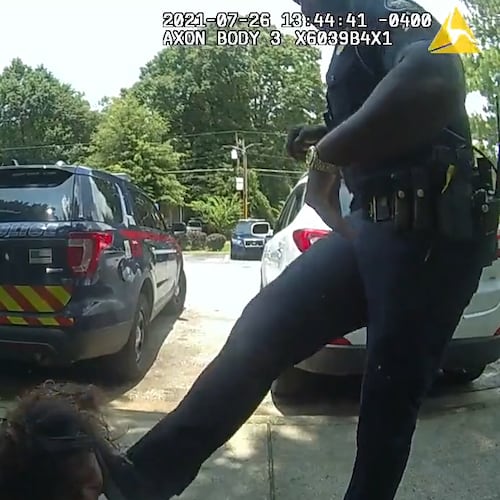The first time Edwin Moses, the greatest athlete in Morehouse College’s history, stepped foot on a track at the college, he had already won gold medals in the 400-meter hurdles at the 1976 and 1984 Olympics.
That’s because in the mid-1970s, when Moses was starring on the college’s track team, Morehouse didn’t have a track, or its own football field.
“I must have broken into every track in the city,” Moses recalled of his training. “But I did whatever it took to win.”
On Tuesday, Morehouse did a grand opening and dedication for the newly renovated Edwin C. Moses Track & B.T. Harvey Stadium Football Field, which opened in 1983.
The track was resurfaced in 1996 for the Centennial Olympic Games, but had since fallen into disrepair.
Credit: Miguel Martinez
Credit: Miguel Martinez
The new, multi-million-dollar renovations will allow the historically Black college in Atlanta to host track meets for the first time in at least a decade. It will also return the Maroon Tigers football team, which practices and played all over the city last year, to campus.
“This will give our program new life,” said Morehouse’s long-time track coach Willie Hill, who plans to host the Morehouse Relays in March.
Part of the renovations was funded by a $1 million donation from philanthropist Billye Suber Aaron, the widow of Hank Aaron.
“This effort has always been about giving scholar-athletes the facilities they deserve,” said Morehouse President David A. Thomas, who noted that the renovations are part of a $500 million capital campaign. “This is part of a broader campaign to build the campus of the future.”
Credit: Miguel Martinez
Credit: Miguel Martinez
Seated on the 30-yard-line of the football stadium’s new field turf, Moses was joined by current members of the Morehouse track team, as well as several former Olympians, including three-time gold medalist Gail Devers.
Moses told a story about how as a student, when he was trying to make the 1976 Olympics team, Morehouse’s athletic department had run out of money. So he appealed directly to then-President Hugh Gloster.
A physics major, Moses explained to him his plan to break the American record at the Olympic trials, then break another record on his way to Olympic gold.
Gloster wrote him a check for $3,000 to train.
“That was the reason why I was able to go forward,” Moses said.
Moses made good on his promise of winning the gold medal in Montreal while setting a world record of 47.63 seconds in the process.
Credit: Getty Images
Credit: Getty Images
Moses, a 1978 graduate of Morehouse, became one of the most dominant figures in track history. Between 1977 and 1987, he won 107 consecutive finals and set the world record in the event four times.
After Tuesday’s ceremony, Moses, who at 66 still looks like he knows his way over a hurdle, quietly walked over to the track that bears his name. He sunk his feet into the sturdy but cushioned surface and smiled.
“This is what I thought my mission was at the time,” Moses said of his time training at Morehouse without a track. “I was just dedicated to getting better on a day-to-day basis. Just getting better.”
About the Author
Keep Reading
The Latest
Featured

